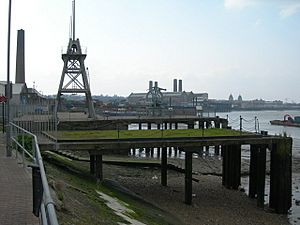Enderby's Wharf facts for kids

Enderby's Wharf is a historic industrial area on the south bank of the River Thames in Greenwich, London. For over 150 years, this site has been famous for making underwater communication cables and related equipment. It's a really important place in the story of how we connect the world through cables under the sea.
Contents
Where is Enderby's Wharf?
This wharf is located on the Greenwich Peninsula. It's a bit north of the main historic part of Greenwich. The site sits between the River Thames and the road that leads to the Blackwall Tunnel. Across the river, you can see Cubitt Town. The whole area is about 16 acres (65,000 square meters) big. It has a riverfront that stretches for about 600 feet (180 meters).
A Brief History of the Wharf
Enderby's Wharf first became a busy commercial spot thanks to a whaling company called Samuel Enderby & Sons. Samuel Enderby II bought the land. Later, Samuel Enderby III, with his brothers Charles and George, started a rope-making business there. They also built Enderby House in the early 1830s. This old house is still standing today, surrounded by newer buildings.
Making Submarine Cables
In 1857, two companies that made submarine cables, Glass, Elliot & Co and W.T.Henley, took over the site. These companies worked together to make the very first transatlantic telegraph cable. This cable connected Europe and North America under the ocean. Glass, Elliot also supplied many other early telegraph cables. These included cables connecting places like Corsica to Sardinia and Malta to Alexandria.
In the 1860s, Glass, Elliot and another company called the Gutta Percha Company joined together. They formed a new company called the Telegraph Construction and Maintenance Company (Telcon). Telcon made a second transatlantic telegraph cable right here at Enderby's Wharf. This cable was successfully laid by a huge ship called the SS Great Eastern. Telcon went on to make many more transatlantic cables. They also made cables that reached far-off places like Australia, New Zealand, India, and Hong Kong.
Modern Cable Technology
In 1935, a new company called Submarine Cables Ltd took over the wharf. During World War II, some parts of the D-Day Pluto pipeline were made here. This pipeline helped supply fuel across the English Channel. Over the years, the company changed hands several times. It was owned by BICC, then AEI, and in 1970, STC.
Making submarine cables at Enderby's Wharf stopped in 1975. The work then focused on making special equipment for optical cables. These are called optical repeaters and amplifiers. Later, the company became part of Northern Telecom, and then Alcatel of France in 1994. In 2006, Alcatel joined with a US company called Lucent to create Alcatel-Lucent. Their division at Enderby Wharf was renamed Alcatel-Lucent Submarine Networks. After Nokia bought Alcatel-Lucent in 2016, it became Alcatel Submarine Networks.
Around 2010, a large part of the wharf was sold to a company that builds homes. This area is now a housing estate called Enderby Wharf. Enderby House, the original office building, was empty for a while. But it has now been turned into a bar and restaurant.
Plans for a Cruise Ship Terminal
Around 2010, there was a plan to turn about 3 acres (12,000 square meters) of the riverfront into a terminal for very large cruise ships. This plan also included building more homes. The local council, Greenwich Council, approved the idea in 2011. The Mayor of London, Boris Johnson, also approved a bigger version of the plan in 2015.
Concerns About Pollution
It was thought that up to 55 large cruise ships might dock there each year. These ships would need to keep their diesel engines running all the time. This is to power everything on board, like lights and air conditioning. Running these engines would create a lot of pollution in the air. This pollution would be very close to homes and schools.
London has strict rules about air quality. However, these rules do not apply to the River Thames itself. The river is controlled by the Port of London Authority (PLA), not the Greater London Authority (GLA). Many local residents and politicians became concerned about the pollution.
In 2018, Greenwich Council changed its mind. They asked the owners of Enderby Wharf, Morgan Stanley, to find a cleaner solution for the cruise terminal. People living in the area suggested a "zero emissions" terminal. This would mean ships could plug into electricity from the shore. This way, they wouldn't need to run their engines while docked. Some cruise ships can already do this, and others are being changed to allow it.
In 2019, Morgan Stanley sold the site. It was bought by Criterion Capital for even more housing development.

